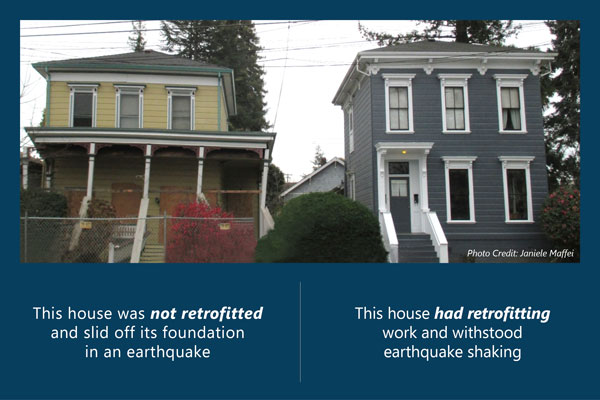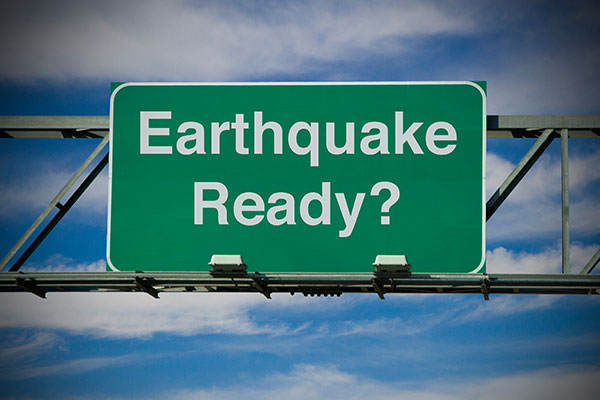Earthquakes aren’t just dangerous – they can also be incredibly expensive. California faces a variety of costly natural disasters. According to CNN Business, our largest earthquakes have set records for being some of the most expensive in US history, including property damage, recovery efforts, and more.
Look at three of the largest earthquakes to hit California in recent history:
- The Great 1906 San Francisco Earthquake caused over $400 million in 1906 dollars in damage, according to USGS.
- The 1989 Loma Prieta Earthquake caused over $6 billion in 1989 dollars in damage, according to the CA Department of Conservation.
- The Northridge Earthquake, which struck in January of 1994, caused an estimated $20 billion in 1994 dollars in residential damage alone, and is believed to be one of the costliest natural disasters in United States history.
The massive costs of earthquakes can impact everybody who lives in California. Public-funded recovery efforts require huge amounts of taxpayer money, and damage to private homes and businesses require enormous expenses from private citizens and sometimes local governments. And of course, rebuilding your home and community after a damaging quake can take months or even years.
The good news is that seismic mitigation measures can help reduce the risk and cost of these disasters. For example, seismic retrofits can help lessen the financial burden for California's homeowners and reduce the economic impact on the state as a whole, while helping to create more resilient communities that are better prepared for future earthquakes.
In this blog, we’ll talk about the economic impact of California earthquakes, as well as the potential hazard mitigation measures you can take to help protect yourself, your family, and your home from being damaged when the ground begins to shake.
The Economic Ripple Effect of Earthquakes
Put simply, earthquakes are very expensive. According to the U.S. Geological Survey and the Federal Emergency Management Agency, “earthquakes cost the nation [the U.S.] an estimated $14.7 billion annually in building damage and associated losses.”
CNN reports that “nearly all of the 10 most expensive earthquakes in U.S. history have hit California.” How do earthquakes create such costly damage? What do they actually do that makes them so expensive?
Let’s look at three types of economic impacts of earthquakes.
Human Costs of Earthquakes
Large earthquakes can take a massive toll on humans both in terms of injury and death, and also suffering, stress, and anxiety. It may be difficult to attribute an exact cost to some of these factors, but they’re equally important to acknowledge as the direct and indirect costs outlined above.
Months after the event, California’s Alfred E. Alquist Seismic Safety Commission (SSC) released a report called “Effects of the Northridge Earthquake,” which stated that nine months after the 1994 Northridge earthquake, many small businesses remain[ed] closed or struggling because the nearby residential properties that housed their normal customer base remain[ed] vacant… nearly 50 percent of the small businesses in the most heavily affected area of Northridge were still not open [and] the commercial district in Fillmore and many commercial properties in communities from the San Fernando Valley to Santa Monica still awaited repairs.”
Clearly, the negative impacts of major earthquakes can cause lasting damage to families and entire communities. These impacts can cause problems for days, weeks, months, or even years.
Direct Costs of Earthquakes
Another way to calculate the costs of these natural hazards is by looking at their direct costs. These are mostly due to the physical damage earthquakes cause to homes and infrastructure. Major earthquakes are capable of damaging almost anything in their path, including homes, commercial or industrial buildings, roads, bridges, or utilities, all of which leads to expensive repairs.
To help put the massive direct costs of major earthquakes into perspective, let’s look at the costs incurred following the 1994 Northridge earthquake. Again, citing the report, “Effects of the Northridge Earthquake:"
- Total economic losses at that time were estimated at $20 billion, making this the single most expensive earthquake in the history of the United States at that time.
- More than 112,000 structures were destroyed. In the City of Los Angeles 93,000 buildings were damaged badly enough to require inspection, and nearly 2,000 buildings (including 1,500 residential buildings) were damaged enough to be red-tagged (forbidding entry).
- 8,800 buildings were damaged enough to be yellow-tagged (meaning they were only safe for limited use).
The Seismic Safety Commission report further explained that the estimated $20 billion in losses were primarily driven by physical damage to structures, and that this estimate did “not include many of the costs related to loss of use, loss of business, loss of productivity, and relocation of businesses.” These other costs are known as the “Indirect Costs” of earthquakes.
Indirect Costs of Earthquakes
Indirect costs of earthquakes include other economic impacts that may be more difficult to measure than simple physical damage. This includes things like job losses, reduced tourism spending, and other negative financial impacts on state and local economies.
Following the Northridge earthquake, the “Effects of the Northridge Earthquake” report quoted above explained that indirect costs of the earthquake were “significant, but often overlooked,” and that the estimated loss of use of parts of the transportation system alone may have contributed to indirect costs of up to “$500 million in delays and lost productivity.”
The report states “Overall productivity losses in the Los Angeles area in the days following the earthquake were estimated at $1 billion,” while “economic effects such as loss of tax revenue, short-and long-term loss of productivity, and ripple effects such as foreclosures, abandonment of equity, and redistribution of commercial activities [were] extremely difficult to calculate with any degree of accuracy.”
To put it simply, the actual total costs of a major earthquake include far more than the repair bills for physical damage.
How Seismic Mitigation Reduces Earthquake Costs
Now that you know how much an earthquake can cost, it’s important to learn about the steps you can take ahead of time to help protect yourself, your family, and your community against seismic activity. While California earthquakes are inevitable, some of the damage and costs they cause may be preventable.
The best way to reduce your earthquake risk is to find out if your home needs an earthquake retrofit. Retrofits don’t guarantee that your home won’t be damaged by major earthquakes, but they can help improve your home’s performance in an earthquake by making it stronger and more resilient.
Utilizing the latest earthquake retrofitting techniques, you can better protect yourself, your family, and your investment from the threat of earthquake damage. Retrofits may reduce costs for earthquake repairs, and they may also qualify you for a 25% discount on your earthquake insurance premium.
The cost of different kinds of retrofits vary widely; a brace and bolt style retrofit can cost between $3,000 and $7,000, while a soft story style retrofit can cost between $15,000 and $25,000 (grant programs are available that can help offset that cost). However, a recent study concluded that seismic retrofits are well worth their cost. The image below shows how two homes next to each other fared after the 2014 Napa earthquake. The one that had retrofitting work done could still be lived in.
You can visit CRMP’s Retrofit Stories page for testimonies from homeowners about the value of a seismic retrofit.
Seismic Mitigation: A Community Effort
In California, earthquake resilience is everyone’s responsibility, and the best way to improve our collective resilience is to strengthen your own home with a seismic retrofit. By retrofitting, homeowners may reduce the risk of damage to their home, and increase the chance that their homes remain habitable after an earthquake. This helps to protect an individual’s investment but also contributes to the safety and stability of the whole community. When more homes are retrofitted, the community is better able to withstand and recover from earthquakes.
If you’re interested in retrofitting your home, we can help! Start by reading our Step by Step Guide to the Earthquake Retrofitting Process.
This Guide covers:
- How to Find a Retrofit Inspection Professional – See our list of local professionals who have successfully taken FEMA training for retrofit inspections.
- How to Find a Qualified Retrofit Contractor – Here, you can view our Contractor Directory to find a local licensed contractor who is trained by FEMA to perform seismic retrofits.
- Submit a Dwelling Retrofit Verification (DRV) Form – After completing your retrofit, visit this page to access a DRV Form to get a Hazard Reduction Discount (HRD) on your earthquake insurance premium.
The California Residential Mitigation Program (CRMP) may also be able to help you secure funding for your retrofit. To help create a stronger and more resilient community, and help safeguard against potentially damaging quakes, we offer two earthquake retrofit grant programs:
- The Earthquake Brace + Bolt (EBB) grant program – EBB grants are for homes built before 1980 on raised foundations or above a crawl space. Qualifying homeowners can receive a grant up to $3,000, and some homeowners may qualify for a Supplemental Grant that can cover up to 100% of the cost of an EBB retrofit. For details on CRMP’s EBB grants, please visit our Guide to the Earthquake Brace + Bolt Retrofit Program, or read our blog post “What is the Earthquake Brace + Bolt Program?”
- The Earthquake Soft-Story (ESS) grant program – ESS grants are for homes that were built before the year 2000 that have a one-story living space over the garage, commonly referred to as “soft story” homes. Qualifying homeowners can receive grants up to $13,000. For details on CRMP’s ESS grants, please visit our Guide to the Earthquake Soft-Story Retrofit Program, or read our Blog Post “What is an ESS Retrofit?”
Unfortunately, grant funding is limited and not every homeowner is eligible. But you can learn more ways to help protect your home and your family from earthquakes if you visit www.strengthenyourhouse.com,
If you have questions about our programs or about any parts of the retrofitting process, please feel free to Contact Us.
What Else Can You Do to Improve Your Earthquake Resilience?
Remember that earthquake preparedness can help protect your property or even save your life, and that the best time to start preparing for the next big earthquake is well before the ground begins to shake!
To help protect your home, yourself, and your loved ones from the serious threat of earthquakes, start your mitigation journey by reading our Guide to Earthquake Preparedness, which can help you and your family create your own disaster response plan. You can also read our articles on the 7 Top Earthquake Safety Tips and learn about the importance of emergency supplies in our article on How to Create an Earthquake Emergency Kit.
Visit our Seismic Strong Blog for more tips, advice and information about earthquakes.





